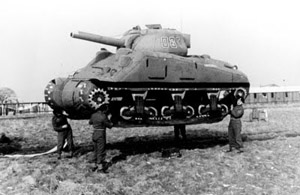During World War II, Germany’s leader Adolf Hitler and his allies, the so called ‘Axis’ powers, were desperate to control Europe and Asia and spread the their ideals throughout the world. Like in any era of sustained warfare, 1939 – 1945 saw the development of many weapons and while most were run of the mill, some were a little more creative and just a little weird.

The idea of an Electric Gun was proposed by the Nazis as a long distance weapon. The huge gun would have been able to fire 750 six-inch shells a minute at a target 90 miles away. Ammunition was to be fed by an automatic conveyer and when fired, solenoids or coreless electromagnets would magnetically pull the missile and send it on its way. The solenoid would then go dead and a new one would take its place, pulling the next missile out and so on.
Although on paper the Electric Gun seems like a weapon with awesome potential, it was totally impractical so never made it past the proposal phase. Useless against smaller targets like ships or troop concentration due to the long range, its main use would have been for bombardment of large scale targets such as cities but the aeroplanes already in use were much better suited to this task.
The Goliath Tank Buster was a remote controlled tank-shaped vehicle designed during the war by German scientists. It was about four feet long, two feet wide and roughly a foot in height and was packed with 75 kg of high explosives, enough to blow up a tank or demolish a building. Once the unfortunate target was established, the vehicle was guided by an engineer, and once in the right position, for example under a tank, the explosives would be detonated and destroy the target.
They were used mostly by specialized Panzer and combat engineer units of the Wehrmacht and were seen on the beaches of Normandy on D-Day June 6th, 1944, although most were quickly rendered inoperative due to damage from artillery blasts.

Despite the high hopes of the weapons, only six people were killed as a result of their deployment and they only managed to inflict a small amount of damage. The Americans made sure that none of the damage that was caused was reported so the Japanese only heard about one incident, that of a balloon reaching Wyoming and causing no harm at all. The Japanese soon realised the ineffectiveness of Fire Balloons and discontinued their use after less than six months.

Railway guns are large pieces of artillery placed on rail tracks and used for long range bombardment. Although they were first used in the 19th century, the ones designed by the Krupp weapons manufacturers in the 1930s and used in WW II deserve special mention as they were quite simply massive.
The biggest were the largest two artillery pieces ever used in combat and were known as ‘Schwerer Gustav’ and ‘Dora’. They weighed around 1,350 tons and could fire 7 ton shells up to 37 kilometers (23 miles) away. Gustav was eventually captured by and destroyed by US troops and Dora was destroyed by the Germans to avoid it falling into enemy hands.
Artillery guns were capable of firing across the English Channel and were designed to destroy heavily fortified positions. However with the rise of the aeroplane there usefulness became limited as they were easily destroyed from the air and similar damage could be inflicted on the enemy with the much cheaper and effective fighter and bomber plains. As a result, the Second World War was the last time Railway Guns were to be used.

Goliath tracked mine, German anti-tank weapon (1944)
Fritz X Guided Bomb
 I’ve stumbled upon an interesting WWII article about “Ghost Army“, an invisible army, operating in obscurity, mastering the arts of illusion, deception, and disinformation to defeat the Nazis in World War II. Something very similar you’ve already seen in Quentin Tarantino’s Inglorious Bastardz.
I’ve stumbled upon an interesting WWII article about “Ghost Army“, an invisible army, operating in obscurity, mastering the arts of illusion, deception, and disinformation to defeat the Nazis in World War II. Something very similar you’ve already seen in Quentin Tarantino’s Inglorious Bastardz.
This top-secret unit, so highly classified that its very existence was denied by the Pentagon for 50 years, is finally being not just exposed, but placed in the spotlight by a Michigan Library and an award-winning documentary filmmaker.
If this interests you, I recommend going through the original article, published on Seattle PI yesterday. Anyway, The Ghost Army was an elite unit made up of artists, designers, sound technicians, press agents, makeup artists, and professional photographers. This may sound weird, but if we remember how US forces, Soviet Army and even Nazis had a paranormal unit at their service, then this shouldn’t surprise us as much. The unit’s mission was to deceive the German Army into believing that the Allies possessed more troops and material than they actually did and, even more heroically, to draw enemy fire on themselves, allowing regular combat units to advance with fewer casualties. They ussed every theatrical tool at their command. A few sound trucks armed with nothing more than loud speakers could “impersonate” a battalion of tanks or an entire infantry division.
Another tool of trickery involved visual deceptions, created using life-size mock-ups of artillery, trucks, planes, tanks, and even buildings. There was a Frenchman coming down the road, and when he saw the scene pictured in above photo, he thought he was hallucinating to see four men pick up a tank. Once again, head over to the original article for more descriptions, and testimonials…

wetwrtr
ReplyDelete